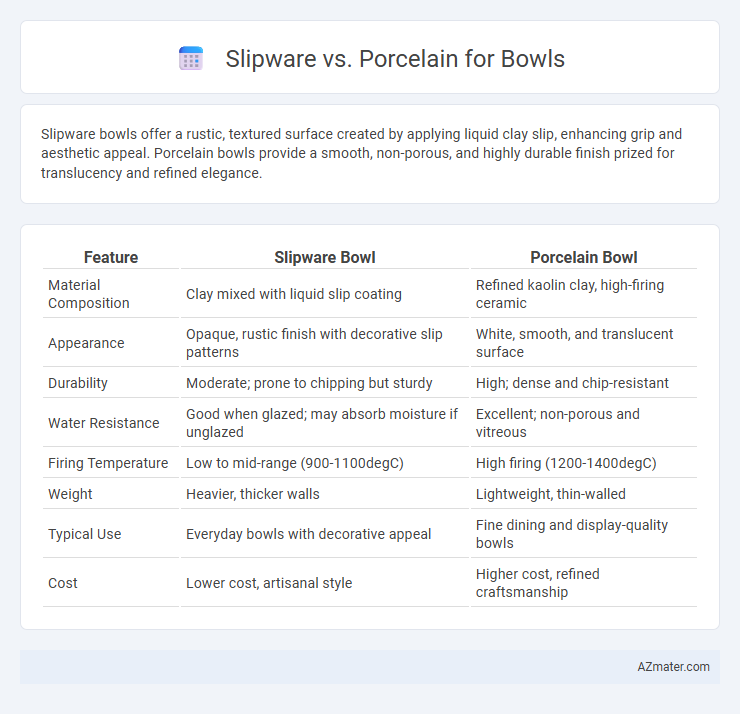Slipware bowls offer a rustic, textured surface created by applying liquid clay slip, enhancing grip and aesthetic appeal. Porcelain bowls provide a smooth, non-porous, and highly durable finish prized for translucency and refined elegance.
Table of Comparison
| Feature | Slipware Bowl | Porcelain Bowl |
|---|---|---|
| Material Composition | Clay mixed with liquid slip coating | Refined kaolin clay, high-firing ceramic |
| Appearance | Opaque, rustic finish with decorative slip patterns | White, smooth, and translucent surface |
| Durability | Moderate; prone to chipping but sturdy | High; dense and chip-resistant |
| Water Resistance | Good when glazed; may absorb moisture if unglazed | Excellent; non-porous and vitreous |
| Firing Temperature | Low to mid-range (900-1100degC) | High firing (1200-1400degC) |
| Weight | Heavier, thicker walls | Lightweight, thin-walled |
| Typical Use | Everyday bowls with decorative appeal | Fine dining and display-quality bowls |
| Cost | Lower cost, artisanal style | Higher cost, refined craftsmanship |
Introduction to Slipware and Porcelain
Slipware is a type of pottery characterized by the application of liquid clay slip to create decorative patterns and textures, often showcasing earthy tones and rustic appeal. Porcelain, on the other hand, is a high-fired ceramic known for its durability, translucency, and smooth, white surface, making it ideal for fine, delicate bowls. Both materials serve distinct aesthetic and functional purposes, with slipware emphasizing artisanal craftsmanship and porcelain offering refined elegance.
Historical Background of Slipware and Porcelain
Slipware originated in ancient civilizations and gained prominence in medieval Europe, characterized by its decorative use of liquid clay slip over earthenware to create intricate patterns. Porcelain, developed in China during the Tang dynasty and perfected in the Song and Ming dynasties, is renowned for its white, translucent quality and high firing temperature that produces a durable, vitrified ceramic. The historical evolution of slipware highlights artisanal creativity in surface decoration, while porcelain reflects advancements in material science and kiln technology.
Material Composition and Characteristics
Slipware bowls are crafted from earthenware clay coated with a liquid clay slip, resulting in a porous and slightly rough texture, ideal for rustic aesthetics. Porcelain bowls consist of fine kaolin clay fired at high temperatures, producing a dense, non-porous, and translucent surface known for strength and elegance. The material composition of porcelain allows for greater durability and a smoother finish compared to the more porous and absorbent slipware.
Production Techniques Compared
Slipware bowls are crafted using a technique where liquid clay slip is applied to the surface before firing, creating decorative patterns and a textured finish, whereas porcelain bowls are produced from highly refined kaolin clay that is fired at higher temperatures for a smooth, vitrified, and translucent quality. Slipware typically involves hand-painting or slip trailing methods that emphasize artistic expression, while porcelain manufacturing often uses precision molding and wheel-throwing to achieve uniform thinness and durability. The distinct firing temperatures also impact the final product's hardness, with porcelain firing at around 1,200-1,400degC yielding greater strength compared to the lower-temperature firings of slipware.
Durability and Functional Use
Slipware bowls offer enhanced durability due to their thicker clay body and protective slip coating, making them resistant to chipping and suitable for everyday use. Porcelain bowls provide a sleek, non-porous surface that resists staining and retains heat effectively but are more prone to cracking or chipping under impact. For functional use, slipware excels in rugged kitchen environments, while porcelain is preferred for elegant presentation and precise temperature control in serving.
Aesthetic Differences: Color, Texture, and Design
Slipware bowls showcase rich, earthy colors with hand-applied liquid clay slips that create tactile, textured surfaces and organic, often rustic designs. Porcelain bowls offer a smooth, glass-like texture with a pure white or translucent base that enhances delicate, precise patterns, often featuring subtle glazes and refined shapes. The aesthetic contrast lies in slipware's robust, artisanal appearance versus porcelain's elegant, minimalist beauty.
Cost and Accessibility
Slipware bowls generally offer a more affordable price point due to their handcrafted techniques and simpler materials, making them accessible to a wide range of consumers. Porcelain bowls, crafted from refined kaolin clay and fired at higher temperatures, tend to be more expensive but provide superior durability and a finer finish. Slipware accessibility is boosted by its popularity in artisanal markets and local pottery studios, whereas porcelain bowls are commonly found in specialty retailers and higher-end kitchenware stores.
Popular Uses: Culinary and Decorative
Slipware bowls, known for their rustic, handcrafted appearance, are popular in culinary settings for serving soups, stews, and salads due to their sturdy, heat-retentive properties. Porcelain bowls, prized for their smooth, non-porous surface and elegant finish, are widely used in fine dining for presenting delicate dishes and desserts, as well as in decorative displays due to their translucency and ability to showcase intricate designs. Both materials offer distinct advantages, with slipware emphasizing artisanal charm and porcelain providing a refined aesthetic and durability in kitchen and decorative contexts.
Care and Maintenance
Slipware bowls require gentle hand washing with mild detergent to preserve their decorative slip coating and prevent chipping, as they are more porous and prone to wear. Porcelain bowls offer greater durability and resistance to stains and scratches, making them suitable for dishwasher use and regular cleaning without compromising their glossy finish. Proper drying of both types is essential to avoid moisture damage; however, porcelain's denser composition provides better long-term maintenance and ease of care.
Choosing the Right Bowl: Slipware vs Porcelain
Slipware bowls offer a rustic, tactile quality with their hand-applied slip decoration and earthy textures, making them ideal for casual dining and artisanal presentations. Porcelain bowls provide a smooth, non-porous surface with exceptional durability and a refined aesthetic, suited for formal settings and everyday use. Choosing between slipware and porcelain depends on the desired balance between artistic character and functional elegance in your bowl selection.

Infographic: Slipware vs Porcelain for Bowl
 azmater.com
azmater.com